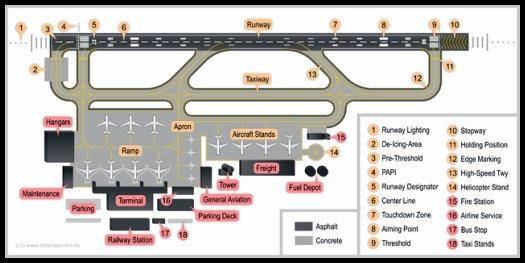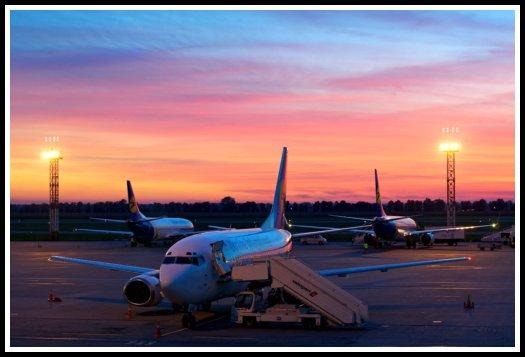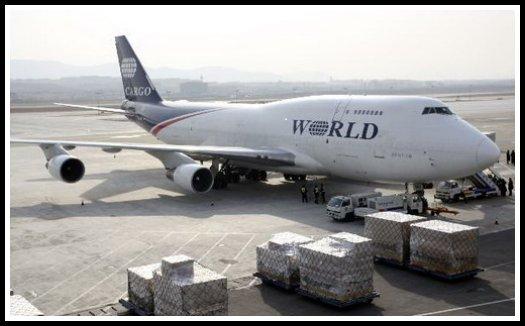Airport infrastructure and services
The devil himself had probably redesigned Hell in the light of information he had gained from observing airport layouts.
- Anthony Price.

Typical infrastructure of an airport
Infrastructure
Smaller or less-developed airports - which represent the vast majority - often have a single runway shorter than 1,000 m (3,300 ft). Larger airports for airline flights generally have paved runways 2,000 m (6,600 ft) or longer. Many small airports have dirt, grass, or gravel runways, rather than asphalt or concrete. In the United States, the minimum dimensions for dry, hard landing fields are defined by the FAR Landing And Takeoff Field Lengths. These include considerations for safety margins during landing and takeoff. Heavier aircraft require longer runways. The longest public-use runway in the world is at Qamdo Bamda Airport in China. It has a length of 5,500 m (18,045 ft). The world's widest paved runway is at Ulyanovsk Vostochny Airport in Russia and is 105 m (344 ft) wide. As of 2009, the CIA stated that there were approximately 44,000 "... airports or airfields recognizable from the air" around the world, including 15,095 in the US, the US having the most in the world.
Airport ownership and operation
Most of the
world's airports are owned by local, regional, or national government bodies
who then lease the airport to private corporations who oversee the airport's
operation. For example, BAA Limited (BAA) operates seven of the commercial
airports in the United Kingdom, as well as several other airports outside of
the UK. Germany's Frankfurt Airport is managed by the quasi-private firm Fraport.
While in India GMR Group operates, through joint ventures, Indira Gandhi
International Airport and Rajiv Gandhi International Airport. Bengaluru
International Airport and Chhatrapati Shivaji International Airport are
controlled by GVK Group. The rest of India's airports are managed by the Airports
Authority of India. In the United States commercial airports are generally
operated directly by government entities or government-created airport
authorities (also known as port authorities), such as the Los Angeles World
Airports authority that oversees several airports in the Greater Los Angeles
area, including Los Angeles International Airport. In Canada, the federal
authority, Transport Canada, divested itself of all but the remotest airports
in 1999/2000. Now most airports in Canada are owned and operated by individual
legal authorities or are municipally owned. Many US airports still lease part
or all of their facilities to outside firms, who operate functions such as
retail management and parking. In the US, all commercial airport runways are
certified by the FAA under the Code of Federal Regulations Title 14 Part 139,
"Certification of Commercial Service Airports" but maintained by the
local airport under the regulatory authority of the FAA. Despite the reluctance
to privatize airports in the US (despite the FAA sponsoring a privatization
program since 1996), the government-owned, contractor-operated (GOCO)
arrangement is the standard for the operation of commercial airports in the
rest of the world.
Airport structures
Airports are divided into landside and airside areas. Landside areas include parking lots, public transportation train stations and access roads. Airside areas include all areas accessible to aircraft, including runways, taxiways and ramps. Access from landside areas to airside areas is tightly controlled at most airports. Passengers on commercial flights access airside areas through terminals, where they can purchase tickets, clear security check, or claim baggage and board aircraft through gates. The waiting areas which provide passenger access to aircraft are typically called concourses, although this term is often used interchangeably with terminal. The area where aircraft park next to a terminal to load passengers and baggage is known as a ramp or "the tarmac". Parking areas for aircraft away from terminals are called aprons. Airports can be towered or non-towered, depending on air traffic density and available funds. Due to their high capacity and busy airspace, many international airports have air traffic control located on site. Airports with international flights have customs and immigration facilities. However, as some countries have agreements that allow travel between them without customs and immigrations, such facilities are not a definitive need for an international airport. International flights often require a higher level of physical security, although in recent years, many countries have adopted the same level of security for international and domestic travel. Some airport structures include on-site hotels built within or attached to a terminal building. Airport hotels have grown popular due to their convenience for transient passengers and easy accessibility to the airport terminal. Many airport hotels also have agreements with airlines to provide overnight lodging for displaced passengers. "Floating airports" are being designed which could be located out at sea and which would use designs such as pneumatic stabilized platform technology.

Ukraine International Airlines Boeing 737 at Zurich Airport
Products and services
Most major airports provide commercial outlets for products and services. Most of these companies, many of which are internationally-known brands, are located within the departure areas. These include clothing boutiques and restaurants. Prices charged for items sold at these outlets are generally higher than those outside the airport. However, some airports now regulate costs to keep them comparable to "street prices". This term is misleading as prices often match the manufacturers' suggested retail price (MSRP) but are almost never discounted. Apart from major fast food chains, some airport restaurants offer regional cuisine specialties for those in transit so that they may sample local food or culture without leaving the airport. Major airports in such countries as Russia and Japan offer miniature sleeping units within the airport that are available for rent by the hour. The smallest type is the capsule hotel popular in Japan. A slightly larger variety is known as a sleep box.
Premium and VIP services
Airports may also contain premium and VIP services. The premium and VIP services may include express check-in, dedicated check-in counters, separate departures and/or arrivals lounge, priority boarding, separate air bridges, and priority baggage handling. These services are usually reserved for First and Business class passengers, premium frequent flyers, and members of the airline's clubs. Premium services may sometimes be open to passengers who are members of a different airline's frequent flyer program. This can sometimes be part of a reciprocal deal, as when multiple airlines are part of the same alliance, or as a ploy to attract premium customers away from rival airlines. Sometimes these premium services will be offered to a non-premium passenger if the airline has made a mistake in handling of the passenger, such as unreasonable delays or mishandling of checked baggage. Airline lounges frequently offer free or reduced cost food, as well as alcoholic and non-alcoholic beverages. Lounges themselves typically have seating, showers, quiet areas, televisions, computer, Wi-Fi and Internet access, and power outlets that passengers may use for their electronic equipment. Some airline lounges employ baristas, bartenders and gourmet chefs. Airlines sometimes operate multiple lounges within the one airport terminal allowing ultra-premium customers, such as first class customers, additional services, which are not available to other premium customers. Multiple lounges may also prevent overcrowding of the lounge facilities.
Cargo / Freight services
In addition to people, airports move cargo around the clock. Cargo airlines often have their own on-site and adjacent infrastructure to transfer parcels between ground and air. Cargo Terminal Facilities International airports need areas where export cargo has to be stored after customs clearance and prior to loading on the aircraft. Similarly import cargo that is offloaded needs to be in bond before the consignee decides to take delivery. Areas have to be kept aside for examination of export and import cargo by the airport authorities. Designated areas or sheds may be given to airlines or freight forward ring agencies. Every cargo terminal has a landside and an airside. The landside is where the exporters and importers through either their agents or by themselves deliver or collect shipments while the airside is where loads are moved to or from the aircraft. In addition cargo terminals are divided into distinct areas - export, import and interline or transhipment.

World Airways Boeing 747 Cargo
Support services
Aircraft maintenance, pilot services, aircraft rental, and hangar rental are most often performed by a fixed base operator (FBO). At major airports, particularly those used as hubs, airlines may operate their own support facilities. Some airports, typically military airbases, have long runways used as emergency landing sites. Many airbases have arresting equipment for fast aircraft, known as arresting gear - a strong cable suspended just above the runway and attached to a hydraulic reduction gear mechanism. Together with the landing aircraft's arresting hook, it is used in situations where the aircraft's brakes would be insufficient by themselves.
Airport access
Many large airports are located near railway trunk routes for seamless connection of multimodal transport, for instance Frankfurt Airport, Amsterdam Schiphol Airport, London Heathrow Airport, London Gatwick Airport and London Stansted Airport. It is also common to connect an airport and a city with rapid transit, light rail lines or other non-road public transport systems, for instance the AirTrain JFK at John F. Kennedy International Airport in New York and the Silver Line T at Boston's Logan International Airport by the Massachusetts Bay Transportation Authority (MBTA). Such a connection lowers risk of missed flights due to traffic congestion. Large airports usually have access also through controlled-access highways ('freeways' or 'motorways') from which motor vehicles enter either the departure loop or the arrival loop.
Internal transport
The distances passengers need to move within a large airport can be substantial. It is common for airports to provide moving walkways and buses. The Hartsfield-Jackson Atlanta International Airport has a tram that takes people through the concourses and baggage claim. Major airports with more than one terminal offer inter-terminal transportation, such as Mexico City International Airport, where the domestic building of Terminal 1 is connected by Aerotrén to Terminal 2, on the other side of the airport.
History and development
The earliest aircraft takeoff and landing sites were grassy fields. The plane could approach at any angle that provided a favorable wind direction. A slight improvement was the dirt-only field, which eliminated the drag from grass. However, these only functioned well in dry conditions. Later, concrete surfaces would allow landings, rain or shine, day or night. The title of "world's oldest airport" is disputed, but College Park Airport in Maryland, US, established in 1909 by Wilbur Wright, is generally agreed to be the world's oldest continually operating airfield, although it serves only general aviation traffic. Bisbee-Douglas International Airport in Arizona was declared "the first international airport of the Americas" by US president Roosevelt . Bremen Airport opened in 1913 and remains in use, although it served as an American military field between 1945 and 1949. Amsterdam Airport Schiphol opened on September 16, 1916 as a military airfield, but only accepted civil aircraft from December 17, 1920, allowing Sydney Airport in Sydney, Australia - which started operations in January 1920 - to claim to be one of the world's oldest continually operating commercial airports. Minneapolis-Saint Paul International Airport in Minneapolis-Saint Paul, Minnesota, opened in 1920 and has been in continuous commercial service since. It serves about 35,000,000 passengers each year and continues to expand, recently opening a new 11,000 foot (3,355 meter) runway. Of the airports constructed during this early period in aviation, it is one of the largest and busiest that is still currently operating. Rome Ciampino Airport, opened 1916, is also a contender. Increased aircraft traffic during World War I led to the construction of landing fields. Aircraft had to approach these from certain directions and this led to the development of aids for directing the approach and landing slope. Following the war, some of these military airfields added civil facilities for handling passenger traffic. One of the earliest such fields was Paris – Le Bourget Airport at Le Bourget, near Paris. The first airport to operate scheduled international commercial services was Hounslow Heath Aerodrome in August 1919, but it was closed and supplanted by Croydon Airport in March 1920. In 1922, the first permanent airport and commercial terminal solely for commercial aviation was opened at Flughafen Devau near what was then Königsberg, East Prussia. The airports of this era used a paved "apron", which permitted night flying as well as landing heavier aircraft. The first lighting used on an airport was during the latter part of the 1920s. In the 1930s approach lighting came into use. These indicated the proper direction and angle of descent. The colours and flash intervals of these lights became standardized under the International Civil Aviation Organization (ICAO). In the 1940s, the slope-line approach system was introduced. This consisted of two rows of lights that formed a funnel indicating an aircraft's position on the glideslope. Additional lights indicated incorrect altitude and direction. Following World War II, airport design became more sophisticated. Passenger buildings were being grouped together in an island, with runways arranged in groups about the terminal. This arrangement permitted expansion of the facilities. But it also meant that passengers had to travel further to reach their plane. An improvement in the landing field was the introduction of grooves in the concrete surface. These run perpendicular to the direction of the landing aircraft and serve to draw off excess water in rainy conditions that could build up in front of the plane's wheels. Airport construction boomed during the 1960s with the increase in jet aircraft traffic. Runways were extended out to 3,000 m (9,800 ft). The fields were constructed out of reinforced concrete using a slip-form machine that produces a continual slab with no disruptions along the length. The early 1960s also saw the introduction of jet bridge systems to modern airport terminals, an innovation which eliminated outdoor passenger boarding. These systems became commonplace in the United States by the 1970s.
UTC | Zulu Time
Copyright © 2012 Roger. All rights reserved. | Sitemap